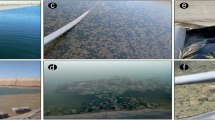Abstract
The phytoplankton communities of thirteen adjacent gravel-pit lakes in the lower Jarama river watershed (Madrid, Spain), were studied during spring mixing and summer stratification.
If different seasons, the phytoplankton responded to different environmental factors. During spring, the abundance of SRP (soluble reactive phosphorus) and existence of a certain thermal stability resulted in the development of a greater biomass in some lakes. During summer, however, excessively high temperatures adversely affected the communities of the warmer lakes. At the species level, the responses were diverse; ordination techniques enabled us to group them.
Some similarities were observed in phytoplankton composition between lakes, possibly due to local dispersion between adjacent lakes (frequented by abundant waterfowl).
Similar content being viewed by others
References
Allen, T. F. H., D. A. Sadowsky & N. Woodhead, 1984. Datatransformation as a scaling operation in ordination of plankton. Vegetatio 56: 147–160.
Alvarez Cobelas, M., A. Rubio, M. Arauzo & V. Alario, 1987. Morfometria y geoquímica de una laguna de gravera. Limnética 3: 91–95.
Alvarez Cobelas, M., A. Baltanás, J. L. Velasco, M. Valladolid, M. Izquierdo & E. Martín, 1993. Slow overturn in a gravel-pit lake. Verh. int. Ver. Limnol. 25: 83–87.
Alvarez Cobelas, M. & M. Arauzo, 1994. Phytoplankton responses to varying time scales in a eutrophic reservoir. Arch. Hydrobiol. Ergebn. Limnol. 40: 69–80.
APHA, 1980. Standard methods for the examination of water and wastewater. 15th edn. American Public Health Assoc. Washington DC, 1134 pp.
Arauzo, M., M. Alvarez Cobelas & A. Rubio, 1987a. Infección por hongos Chytridiales en una población de Oocystis borgei (Oocystaceae, Chlorophyceae). Acta Bot. Malacitana 12: 35–43.
Arauzo, M., M. Alvarez Cobelas & A. Rubio, 1987b. Efecto de una infección de hongos Chytridiales (Phycomycetes) sobre una población natural del alga Fotterella tetrachlorelloides Buck (Chlorophyceae, Oocystaceae).
Arauzo, M. & M. Alvarez Cobelas, 1994a. Respuesta de la comunidad fitoplanctónica a la estacionalidad en un embalse eutrófico. Limnética 10: 37–42.
Arauzo, M. & M. Alvarez Cobelas, 1994b. Phytoplankton strategies and time scales in a eutrophic reservoir. Hydrobiologia 291: 1–9.
Barone, R. & L. N. Flores, 1994. Phytoplankton dynamics in a shallow, hypertrophic reservoir. Hydrobiologia 289: 199–214.
Díez, J. A., R. Román, M. C. Cartagena, A. Vallejo, A. Bustos & R. Caballero, 1993. Controlling nitrate pollution of aquifers by using different nitrogenous controlled release fertilizers in maize crop. Agricult., Ecosyst. Envir. 48: 49–56.
Dixon, W. J., M. B. Brown, L. Engelman, J. W. Frane, M. A. Hill, R. I. Jennrich & J. D. Toporek, 1992. BMDP statistical software manual. Vol. 1, 2. Univ. California Press, Berkeley, 1500 pp.
Dumont, H. J., I. van de Velde & S. Dumont, 1975. The dry weight estimate of biomass in a selection of Cladocera, Copepoda and Rotifera from the plankton, periphyton and benthos of continental waters. Oecologia 19: 75–97.
Eloranta, P., 1993. Diversity and succession of the phytoplankton in a small lake over a two-year period. Hydrobiologia 249: 25–32.
Harris, G. P. & A. M. Trimbee, 1986. Phytoplankton population dynamics of a small reservoir: Physical/biological coupling and the time scales of the community change. J. Plankton Res. 8: 1011–1025.
Kuzyakhmetov, G. G., 1978. Dispersal of algae in atmosphere in the winter. Sov. J. Ecol. 9: 473–475.
Le Cohu, R., N. Comoy, J. Guitard & J. Brabet, 1991. Périodicié du phytoplancton dans un réservoir de moyenne profondeur: le lac Pareloup (Massif Central, France), un exemple de succession cyclique. Ann. Limnol. 27: 197–214.
Lund, J. W. G., 1978. Changes of the phytoplankton of an English lake, 1945–1977. Hydrobiol. 114: 6–21.
Lund, J. W. G., C. Kippling & E. D. Le Cren, 1958. The inverted microscope method of estimating algal numbers and the statistical basis of estimations by counting. Hydrobiologia 10: 143–170.
Marker, A. F. H., E. A. Nusch, H. Rai, B. Riemann, 1980. The measurement of photosynthetic pigments in freshwaters and standardization of methods: conclusions and recommendation. Arch. Hydrobiol. Ergebn. Limnol. 14: 91–106.
Masters, M. J., 1971. The ecology of Chytridium deltanum and other fungus parasites on Oocystis sp. Can. J. Bot. 49: 75–87.
OECD, 1982. Eutrophication of waters. Monitoring, assessment and control. OECD, Paris, 155 pp.
Olrik, K. & A. Nauwerck, 1993. Stress and disturbance in the phytoplankton community of a shallow, hypertrophic lake. Hydrobiologia 249: 15–24.
Pearsall, W. H., 1930. Phytoplankton of English lakes. I. The proportion in the waters of some dissolved substances of biological importance. J. Ecol. 18: 306–320.
Proctor, V. W., 1966. Dispersal of desmids by waterbirds. Phycologia 5: 227–232.
Reynolds, C. S., 1984. Phytoplankton periodicity: the interaction of form, function and environmental variability. Freshwat. Biol. 14: 111–142.
Reynolds, C. S. & E. G. Bellinger, 1992. Patterns of abundance and dominance of the phytoplankton of Rostherne Mere, England: evidence from 18-year data set. Aquat. Sci. 54: 10–36.
Rott, E. A., 1981. Some results of phytoplankton counting intercalibrations. Schweiz. Z. Hydrol. 43: 34–62.
Schlichting, H. E., 1969. The importance of airborne algae and protozoa. J. Air Pollut. Control Ass. 19: 946–995.
Sommer, U., 1981. The role of r- and K-selection in the succession of phytoplankton in lake Constance. Acta Oecol. 4: 327–342.
Sommer, U., Z. M. Gliwicz & A. Duncan, 1986. The PEG-model of seasonal succession of planktonic events in fresh waters. Arch. Hydrobiol. 106: 433–471.
Utermöhl, H., 1958. Zur Vervollkomnung der quantitativen Phytoplankton-Methodik. Mitt. int. Ver. Limnol. 9: 1–38.
Van Donk, E., 1989. The role of fungal parasites in phytoplankton succession. In U. Sommer (ed.), Plankton ecology. Springer-Verlag. Berlin: 171–194.
Vrba, J., V. Vyhnálek, J. Hejzlar & J. Nedoma, 1995. Comparison of phosphorus deficiency indices during a spring phytoplankton bloom in a eutrophic reservoir. Freshwat. Biol. 33: 73–81.
Wetzel, R. G., 1981. Limnologia. Omega, Barcelona, 679 pp.
Wetzel, R. G. & G. E. Likens, 1991. Limnological analyses. Springer-Verlag, New York, 391 pp.
Author information
Authors and Affiliations
Rights and permissions
About this article
Cite this article
Arauzo, M., Cobelas, M.A., Vicioso, J. et al. The phytoplankton of some gravel-pit lakes in Spain. Hydrobiologia 333, 19–27 (1996). https://doi.org/10.1007/BF00020960
Received:
Revised:
Accepted:
Issue Date:
DOI: https://doi.org/10.1007/BF00020960




